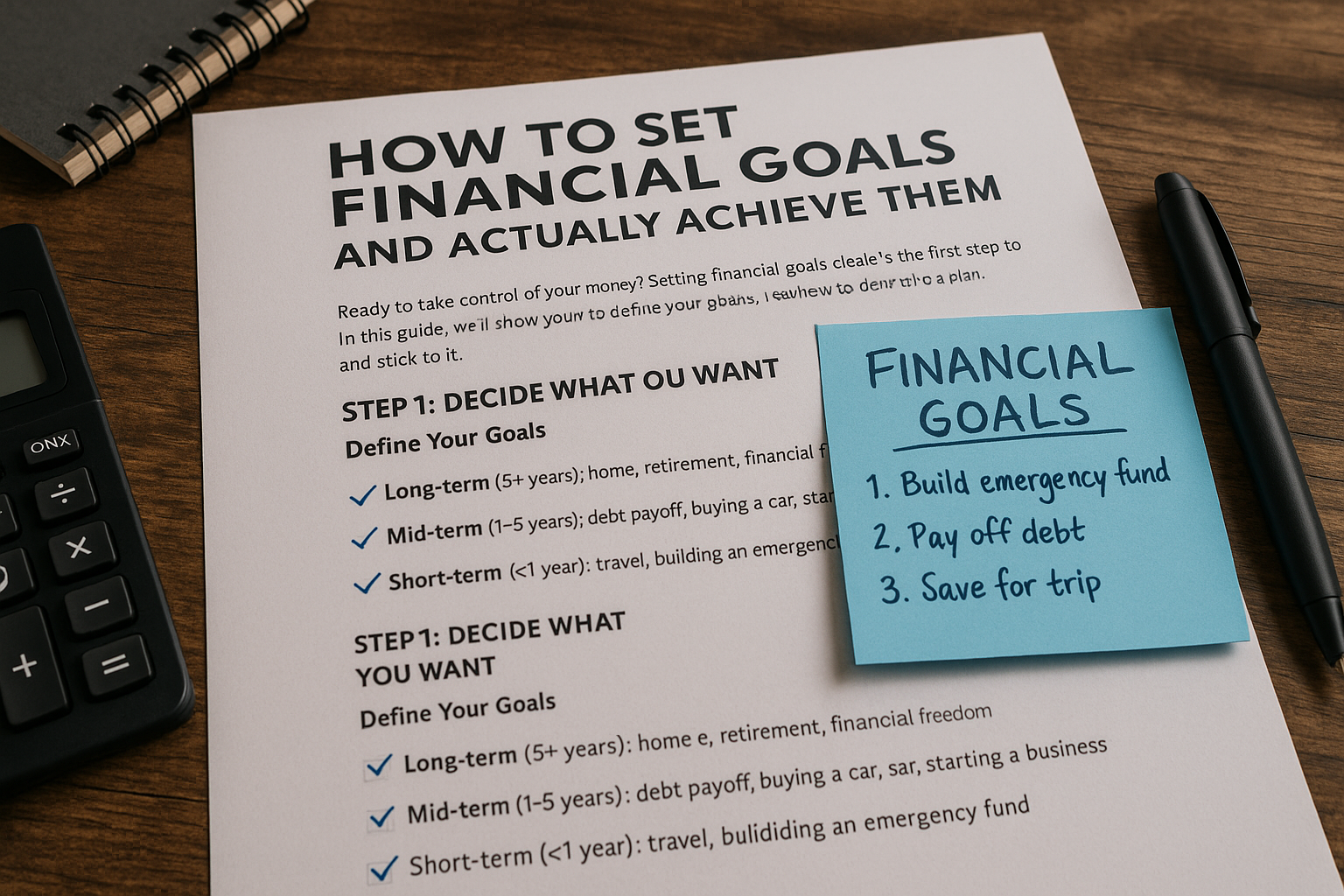Financial goals are the foundation of a strong, stable, and purpose-driven money plan. Whether you’re trying to pay off debt, save for a dream vacation, or retire early, setting clear goals—and knowing how to stick to them—is what turns intention into real progress.
In this article, you’ll learn how to define your financial goals, create a plan to reach them, and build the mindset and habits needed to stay consistent along the way.
Why Financial Goals Matter
Without goals, money tends to slip away unnoticed. Having clear objectives helps you:
- Stay focused and disciplined
- Prioritize spending and savings
- Track progress and stay motivated
- Avoid lifestyle inflation
- Make long-term dreams a reality
Think of your financial goals as the GPS for your money—it tells you where you’re going and keeps you from getting lost.
Step 1: Identify Your Financial Priorities
Before setting goals, take time to reflect on what truly matters to you. What do you want money to help you achieve?
Common priorities include:
- Paying off credit card or student loan debt
- Building an emergency fund
- Saving for a home down payment
- Traveling the world
- Starting a business
- Retiring early or comfortably
Everyone’s financial goals will look different based on life stage, income, and values—and that’s okay.
Step 2: Set SMART Financial Goals
To set yourself up for success, use the SMART method:
- Specific: What exactly do you want to achieve?
- Measurable: Can you track progress numerically?
- Achievable: Is this realistic given your income and expenses?
- Relevant: Does this goal align with your current priorities?
- Time-bound: When do you want to achieve it?
Example of a SMART goal:
“Save $6,000 for a vacation to Italy by December 2025 by saving $250/month.”
This is far more actionable than just saying, “I want to save more.”
Step 3: Break Big Goals Into Mini Milestones
Large goals can feel overwhelming. Breaking them into smaller parts makes them more manageable and encourages steady progress.
Instead of:
“Pay off $15,000 in credit card debt.”
Try:
“Pay off $3,000 in 6 months, $6,000 in 1 year,” and so on.
Celebrate each milestone. Every win builds confidence and momentum.
Step 4: Create a Budget That Supports Your Goals
Once your goals are clear, your budget should reflect them. This means prioritizing savings or debt payments over unnecessary spending.
Budgeting methods to consider:
- Zero-based budget: Every dollar has a job.
- 50/30/20 rule: 50% needs, 30% wants, 20% savings/debt.
- Cash envelope method: Useful for controlling overspending in variable categories.
Tip:
Set up automatic transfers to savings or debt accounts. Make your goals the first “bill” you pay.
Step 5: Choose the Right Financial Tools
The right tools can help you stay on track and motivated.
Apps and tools to consider:
- You Need a Budget (YNAB) or Mint for budgeting
- Qapital or Digit for automatic saving
- Personal Capital for net worth tracking
- A spreadsheet for visualizing your progress
Use what fits your style—digital or analog—as long as it helps you stay consistent.
Step 6: Track Progress Monthly
Just like with fitness or health goals, regular check-ins are essential.
Each month:
- Review how much you saved or paid off
- See what’s working and what’s not
- Adjust if needed (more income, fewer expenses, extended timelines)
Progress won’t always be linear, and that’s okay. The key is to stay engaged and course-correct as needed.
Step 7: Build a Support System
Accountability boosts success. Don’t keep your goals to yourself—share them with someone you trust.
Ideas:
- Partner with a “money buddy”
- Join a personal finance community (Reddit’s r/personalfinance, Facebook groups)
- Work with a financial coach or planner
- Use a journal to track your thoughts and feelings about money
It’s easier to stay motivated when you know you’re not alone.
Step 8: Prepare for Setbacks
Life happens—unexpected expenses, job changes, family emergencies. Plan for these by:
- Maintaining an emergency fund
- Creating a “setback plan” in your budget
- Being flexible with timelines, but not giving up on the goal
Progress may slow, but persistence always pays off.
Step 9: Reward Yourself Along the Way
Don’t wait until you reach your final goal to celebrate. Build in small, guilt-free rewards when you hit milestones.
Examples:
- Dinner at your favorite restaurant
- A short weekend trip
- Buying something meaningful (within reason)
Rewarding yourself makes the journey feel more enjoyable—and sustainable.
Step 10: Reflect, Adjust, and Set New Goals
Once you achieve a goal, don’t stop. Reflect on what worked, what didn’t, and what’s next.
Questions to ask:
- Did I stay within budget?
- Did I underestimate or overestimate my timeline?
- What habits helped me succeed?
Then, use your experience to set new, even better goals.
Final Thoughts: Goals Give Your Money Purpose
Financial goals give your money a job—and your life more freedom. By turning vague intentions into actionable, trackable plans, you’ll be amazed at what you can accomplish.
Remember: it’s not about being perfect, it’s about being intentional. Take the first step today, stay consistent, and watch your financial life transform.
